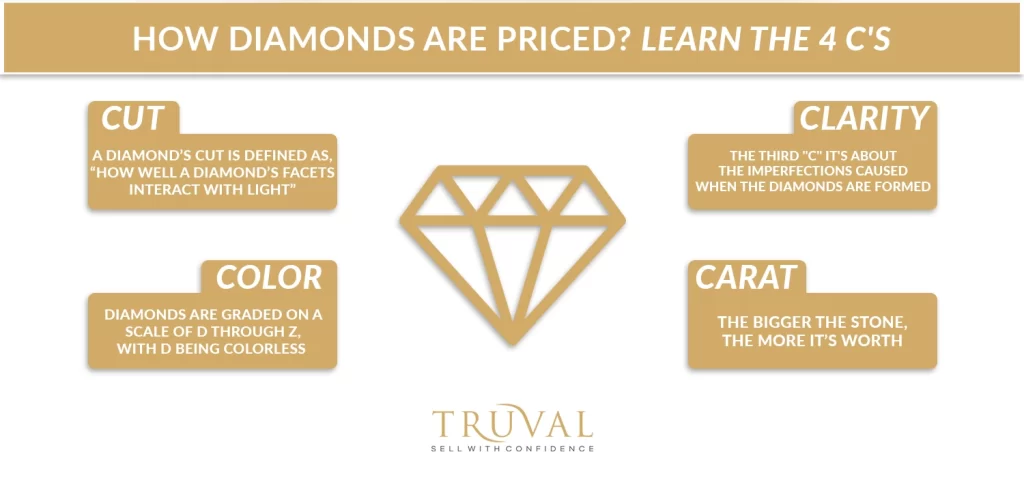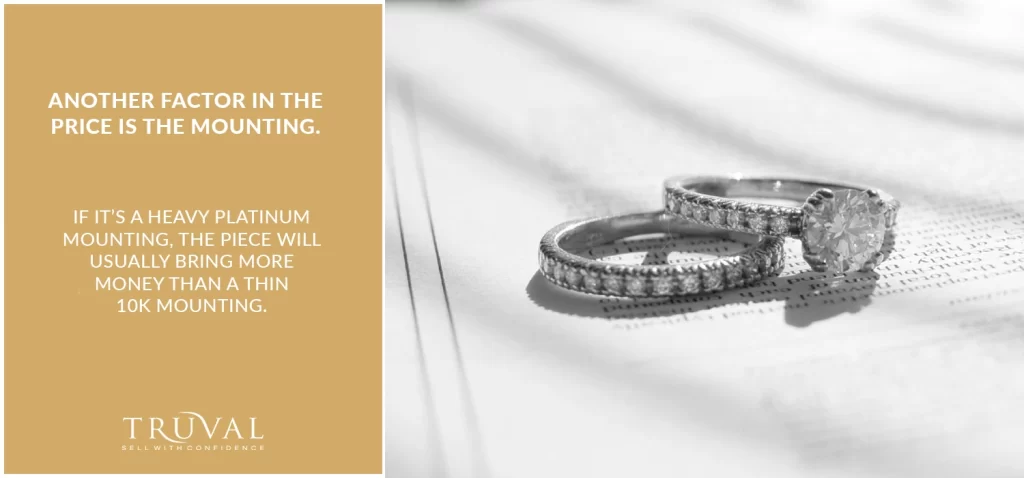Juicers, board games, golf clubs, and exercise equipment—we all own stuff that collects dust. The same goes for fine jewelry. How many of us own diamond earrings, bracelets, and rings we never wear anymore? Say Aye! But here’s the difference. Those gems may literally be gems; long-buried treasures. Whether you have a single piece or an entire drawer full, your jewelry is worth an appraisal. A divorce, broken engagement, or other circumstances may tempt you to unload the finery. But before you do, make sure you have some knowledge under your belt so there’s no danger of being taken advantage and getting paid much less than your piece is worth.
So how are diamonds priced, anyway? This is probably the first and foremost question that runs through your mind when deciding whether to sell your unwanted jewelry. After all, diamonds, gold, and platinum are known to go up and down in value. Do some research. Find out just how much diamonds have appreciated in 20 years. You may be surprised. A used diamond’s price could potentially be well above what you paid.
The Value of Diamonds: Learn the 4 C’s

The fact is, diamonds have worth, and sometimes a lot of it. Truval knows how to recognize the value of diamonds, and we want you to, as well. That’s why we’ve created an in-depth guide to help you understand the process involved in making these types of determinations. For instance, we’ll educate you on the pricing of diamonds per carat, which hinges on five important points. And then there are what we call the 4 C’s, described below and include the cut, the color, the clarity and the carat size.
How Diamonds are Priced: Cut
To determine how diamonds are priced, let’s begin with the cut of the gemstone. Many people think “cut” refers to the diamond’s shape—if it’s round, oval, princess, or cushion-cut. But that’s not the case. According to the Gemological Institute of America, a diamond’s cut is defined as, “how well a diamond’s facets interact with light.”
The cut is one of the most influential factors that determines the level of sparkle or fire we see in a stone. The scale measures from “excellent” to “poor” and everything in between. Jewelers measure the facets of a diamond to calculate the cut. Those on the “excellent” to “very good” end of the spectrum reflect more light and exhibit exceptional brilliance. These are the more expensive diamonds.
What this means to you: After you clean your diamond, put it under a light and see how much it sparkles. If it brightly fires, and all facets sparkle, you most likely have a higher quality cut. However, if it seems a bit dull and the middle part of the stone is dark, chances are it has less value.
If you don’t possess papers from your diamond’s purchase, finding a reputable jeweler to study your piece and determine the diamond’s cut is the easiest way to figure out how much your used diamond’s price should be.
How Diamonds Are Priced: Color
Look at the color of your (white) diamond—or more precisely, lack of color—because the less it has, the better. Diamonds are graded on a scale of D through Z, with D being colorless. The most expensive and rare grade is a D. From there, each grade will then reveal more color presence, little by little. While it’s difficult for the average jewelry buyer to see a big difference between a D- and F-colored stone, a distinct and noticeable difference is visible between a D and I colored stone. Move into the J and K range and the stone has a visible tinge of yellow or brown in the stone.
What this means to you: Lay your diamond on a piece of white paper and compare. If the diamond is a similar color to the paper, your piece is most likely a higher and more expensive grade. If you see your stone show up as yellow or beige against the paper, it’s most likely a lower grade. Truval can give you an accurate color grade if you desire. A high grade in color is a key aspect of how a diamond is priced because a near colorless diamond is gorgeous, whether worn on your finger, around your neck, or in your ears.
How Diamonds Are Priced: Clarity
The third “C” that weighs into how diamonds are priced deals with the imperfections caused when the diamonds are formed. Sometimes, diamonds form with few imperfections or inclusions, and these are the higher quality, higher value stones. Other times, diamonds contain small bits of black carbon inside that is visible by either loop or the naked eye. They may also present an imperfection on the outside of the stone, known as a blemish. Both of these decrease the value of the stone.
Clarity is graded starting with “very, very slightly included,” then “very slightly included,” “slightly included,” and “included.” Each of these grades has a 1 and 2 designation as well. Truval arrives at how diamonds are priced by studying the size of the inclusion or blemish, where it is located, the number of imperfections the stone contains, and how they impact the look of the stone overall.
What this means to you: Clarity is difficult to assess with the naked eye. Start by examining your diamond from the top down. Do you see any small black dots inside or small specs that resemble burned out light bulbs? These are inclusions that can decrease what your diamond is worth. If you have access to a jeweler’s loop, use that for the analysis, as diamonds are graded by what can be seen under a 10X loop.
How Diamonds are Priced: Carat
The pricing of diamonds per carat is the most obvious way to determine how much your diamond jewelry is worth. Generally, the bigger the stone, the more it’s worth. But other characteristics of the gem also factor in. Sometimes a high quality smaller stone that is colorless and contains no inclusions will be worth more than a large stone with visible inclusions and a yellow tint.
This means you should eyeball your stone and measure its width. If it’s the size of a pencil eraser or bigger, you have a nice size stone that is probably worth a tidy sum. If it’s small, or if you have a cluster of small diamonds, they won’t bring in nearly as much if you decide to sell it. Truval can help you get a better idea of your used diamond’s price.
Other Factors That Play into How Diamonds Are Priced

In addition to the 4 C’s, there are other influencers at play that affect your diamond’s worth. The shape of the stone is one. Some shapes, such as cushion-cut or emerald, take much longer to produce and tend to sell at a higher price.
Another factor is the mounting. If it’s a heavy platinum mounting, the piece will usually bring more money than a thin 10k mounting.
And finally, the economy plays a part in how diamonds are valued. A booming economy might help your piece sell for hundreds more than it would during a recession. When you look at how much diamonds have appreciated in the last 20 years, you can see ebbs and flows in value.
Whether you have diamond jewelry you bought yourself, was inherited or gifted and is just not your taste, it’s not doing you any good laying in the jewelry box!
Why not sell it and buy something you love, invest it in stocks, or go on the vacation of your dreams? Examine your piece and then contact a Truval to help you get top dollar.
If you’d like to know how much your diamond ring is worth, it pays to speak with a professional and get a quote.
